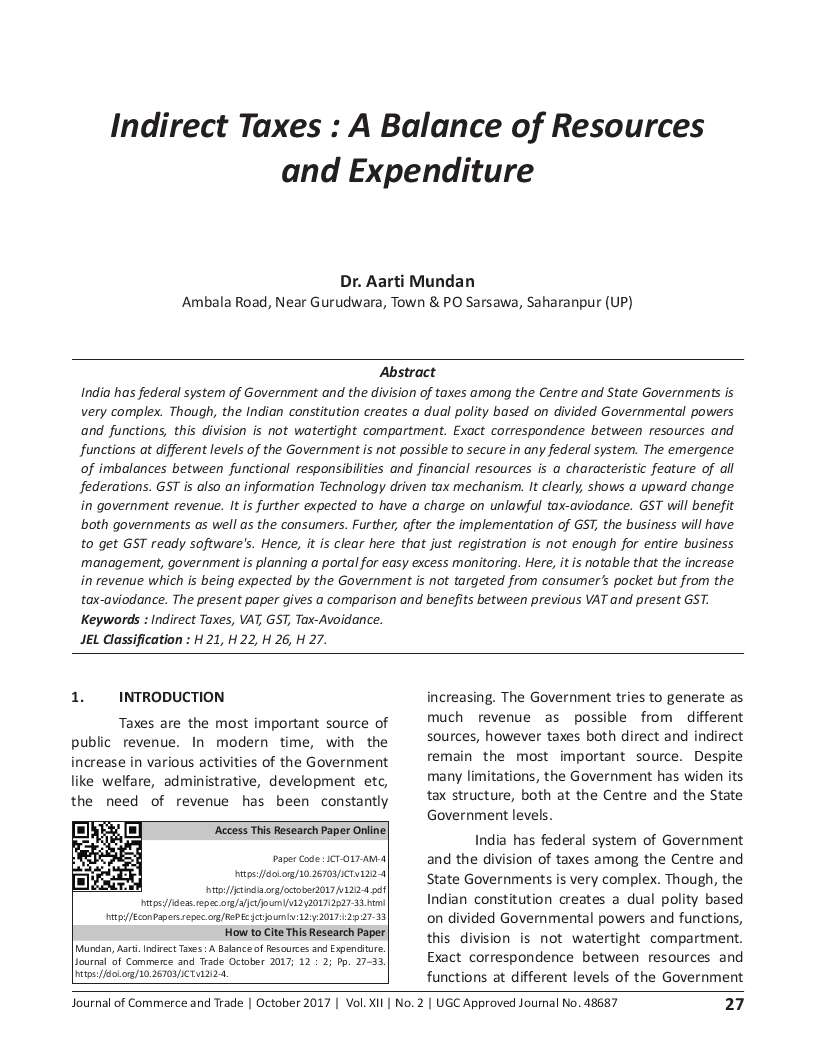Indirect Taxes: A Balance of Reources and Expenditure
DOI:
https://doi.org/10.26703/jct.v12i2.140Keywords:
Indirect Taxes, VAT, GST, Tax-AvoidanceAbstract
India has federal system of Government and the division of taxes among the Centre and State Governments is
very complex. Though, the Indian constitution creates a dual polity based on divided Governmental powers
and functions, this division is not watertight compartment. Exact correspondence between resources and
functions at different levels of the Government is not possible to secure in any federal system. The emergence
of imbalances between functional responsibilities and financial resources is a characteristic feature of all
federations. GST is also an information Technology driven tax mechanism. It clearly, shows a upward change
in government revenue. It is further expected to have a charge on unlawful tax-aviodance. GST will benefit
both governments as well as the consumers. Further, after the implementation of GST, the business will have
to get GST ready software's. Hence, it is clear here that just registration is not enough for entire business
management, government is planning a portal for easy excess monitoring. Here, it is notable that the increase
in revenue which is being expected by the Government is not targeted from consumer’s pocket but from the
tax-aviodance. The present paper gives a comparison and benefits between previous VAT and present GST.
Classification-JEL: H 21, H 22, H 26, H 27.
Downloads
Metrics
References
Murali, D. “Into the VAT of Unknown. Business Line 1 Apr. 2003: 4.
National Council of Applied Economic Research. Moving to Goods and Service Tax in India: Impact on
India's Growth and International Trade. New Delhi: NCAER, 2009.
Nazarudeen, T. “Govt. will Consider Our.” Kerala Calling 26. 5 (2005): 26.
Nimbur, Basawaraj N. Introduction to Value Added Tax: Feasibility, Problems and Prospects. New Delhi:
Criterion, 1984.
Padmanabhan, V. “Finances of State Governments and VAT Reforms.” Southern Economist. 48. 10
(2009): 5-7.
Pandey, I. M. Financial Management. 7 th Rev. ed. New Delhi: Vikas, 1995.
Patel, Chirag. “VAT Audit.” The Chartered Accountant Student. 12. 10 (2009): 15-18.
Pattabhi Ram, V., and S. D. Bala. Management Accounting and Financial Analysis. 2 nd ed. Mumbai:
Snow White, 2007.
Paul, M. L., and Jenny Thekkekkara. “VAT in Kerala: Rationale, Features and Transitional Issues.” Kerala
Calling 26. 5 (2005): 14-19.
Pillai, G. K. VAT: A Way Out of the Indian Tax Muddle. 3 rd ed. Mumbai: Jaico, 2003.
Prabhakara Menon, B. “A Transparent and Legitimate method of Tax collection.” Kerala Calling 26. 5
(2005): 27.
Navjot (2010), “Structure and Implementation of VAT in Punjab: an Evaluation”, A U.G.C. Research
Project, Post-Graduate Department of Economics, Khalsa College, Amritsar.
Nour, Abdul Naser I.; and Pramanik, Alok Kumar (2005), “Value Added Tax: A Suggested Method”, in
Pramanik, Alok Kumar (Ed.), Value Added Accounting and Reporting VAT, Kanishka Publishers, New
Delhi.
Poddar, Satya; and Ehtisham, Ahmad (2009), “GST Reforms and Intergovernmental Considerations in
India”, Working Paper No. 1/2009-DEA, Department of Economic Affairs, Ministry of Finance,
Government of India.

Downloads
Published
How to Cite
Issue
Section
License
Copyright (c) 2017 Dr. Arti Mundan

This work is licensed under a Creative Commons Attribution 4.0 International License.














